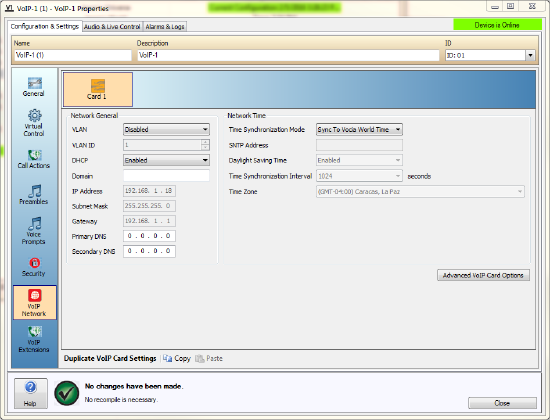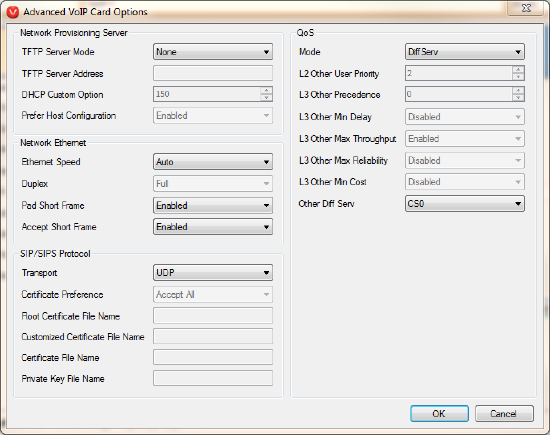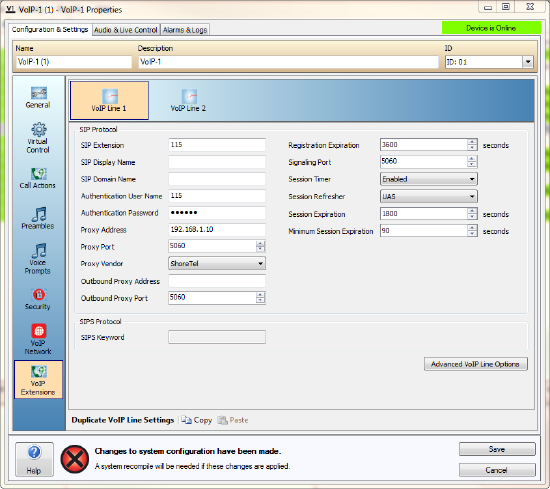Shoretel VoIP configuration for Vocia VoIP-1
Biamp’s VoIP-1 allows Biamp Vocia systems to utilize Voice-over-IP (VoIP) systems that adheres to the SIP (Session Initiation Protocol) standard. The interface permits live, real-time paging using any page code within the Vocia system using the VoIP telephone extension as the paging source. The VoIP-1 is available with one or two VoIP network ports. Each port will support up to two lines. This document details the steps required to configure a Shoretel system to work with Biamp’s VoIP-1. For information regarding the parameters not covered in this article, please refer to the Vocia help.
Preliminary steps
The first step in setting up the ShoreTel system is to verify that the proper amount of SIP licenses are in place. Each VoIP-1 port can support up to two lines and 2 ports may be present in a single VoIP-1 (VoIP-1-4). The ShoreTel system will require a SIP Phone License for each extension assigned to the VoIP-1. The steps to verify the license count are detailed below. If it is discovered that there are not enough licenses available, contact the VoIP Admin.
Go to Administration ->System Parameters-> Licenses -> Requirements.
- ShoreTel SIP Phone License Purchased must be equal or greater than the number of lines to be assigned to the VoIP-1. Purchased Licenses will move to Configured Licenses after the ShoreTel system has been fully configured.
Configuring the ShoreTel server
Creating a new user
Add a new User to the ShoreTel system.
- Go to Administration —> Users -> Individual Users.
- Select the site where you would like to add a User.
- Click Go.
Setting up the new user
The steps below outline the process setting up the new user account in ShoreTel. All of the following steps are located in the Edit User page accessed from the previous step. Note that any configuration settings not explicitly detailed in this section can be left at the default value.
- Enter a name for the user.
- Enter the extension number to be used in the Number field.
- Change the License Type to Extension Only or Extension + Mailbox. The latter should be used if a Voicemail account will be created for the card.
- Change the Access License to match what would be expected of the card in the current ShoreTel setup. This setting does not effect the VoIP-1 functionality, it simply helps in ShoreTel organization.
- Enter Caller ID if desired.
- Enter DID info if desired.
- Set PTSN Failover to None.
- Set the User Group that makes the most sense in the ShoreTel setup.
- The correct Primary Phone Port selection is based off of the entry in Step 3. Apply the setting based on the criteria below:
If Extension Only was used in Step 3 select SoftSwitch for the Primary Phone Port. Then select SoftSwitch from the pull-down menu.
- If Extension + Mailbox was used in Step 3 select IP Phones for the Primary Phone Port. Then select Any IP Phone.
VoIP-1 Configuration
After all ShoreTel settings have been entered, follow the steps below to set up the VoIP-1.
Configuring the network settings
 Open the Vocia software, and connect to your system.
Open the Vocia software, and connect to your system.- Double-click on the VoIP-1 that is located in the Audio Inputs folder of your World. At the top of the window, the Configuration & Settings tab should be selected.
- Select the VoIP Network icon located on the left side of the window.
- Under the Network General section in the Properties Sheet, set VLAN to Enabled if your VoIP network uses a tagged VLAN. If the network uses an untagged VLAN or no VLAN, leave this value as Disabled. If VLAN is enabled, enter the correct VLAN ID.
- Under the Network General section, leave DHCP set to Enabled if the VoIP-1 will obtain an IP address automatically from a DHCP server. Otherwise, set it to Disabled, and manually enter an appropriate static IP Address, Subnet Mask, and Gateway for the device.
 Select the Advanced VoIP Card Options button to open the advanced settings window.
Select the Advanced VoIP Card Options button to open the advanced settings window.- Under the SIP/SIPS Protocol section, ensure that Transport is set to UDP.
- Configure any other options as necessary in this window and click the OK button to close the window.
Configuring the VoIP settings
 Select the VoIP Extensions icon located on the left side of the window.
Select the VoIP Extensions icon located on the left side of the window.- Select the appropriate VoIP line at the top that is to be configured.
- In the SIP Extension field, enter the Extension Number used in the ShoreTel settings.
- In the Authentication User Name field, enter the Extension Number used in the ShoreTel settings.
- In the Authentication Password field, enter the SIP Password used in the ShoreTel settings.
- Select ShoreTel as the Proxy Vendor.
- In the Proxy Address field, enter the IP address of the ShoreTel ShoreGear switch.
- Set the Session Refresher field to UAS.
- Custom RTP, QoS, and NAT features are configured by selecting the Advanced VoIP Line Options button. If your network prioritizes VoIP traffic using Quality of Service (QoS), select the QoS tab and enter the appropriate settings for your network. Otherwise, skip this step. By default, only the Diffserv attributes are available. If you prefer specifying QoS using TOS, select TOS as the QoS mode from the Advanced VoIP Card Options and return to this page.
- If you’re configuring multiple lines, select the line at the top of the page and repeat steps 8-14.
- All other settings can remain at their default values in most cases.
- Once all changeds have been made, you must send the system configuration. Send the system configuration to the Vocia system (Network—>Send Configuration to System). Once the configuration is loaded, the VoIP-1 will attempt to register with the proxy server. You can check the status by opening the VoIP-1 properties page and selecting the Audio & Live Control tab. Select the VoIP General icon at the top check the SIP Registered field for the current registration status.
Further reading
- Online Vocia VoIP-1 Help
- For more in-depth troubleshooting a Wireshark Trace should be performed on the system.

